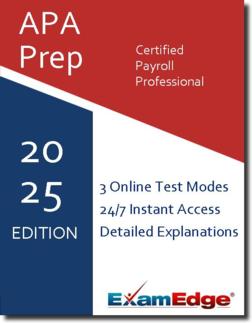APA Certified Payroll Professional (CPP) Practice Tests & Test Prep by Exam Edge - Topics
Based on 28 Reviews
- Real Exam Simulation: Timed questions and matching content build comfort for your APA Certified Payroll Professional test day.
- Instant, 24/7 Access: Web-based APA Certified Payroll Professional practice exams with no software needed.
- Clear Explanations: Step-by-step answers and explanations for your APA exam to strengthen understanding.
- Boosted Confidence: Reduces anxiety and improves test-taking skills to ace your APA Certified Payroll Professional (CPP).

Understanding the exact breakdown of the APA Certified Payroll Professional test will help you know what to expect and how to most effectively prepare. The APA Certified Payroll Professional has 125 multiple-choice questions The exam will be broken down into the sections below:
| APA Certified Payroll Professional Exam Blueprint | ||
|---|---|---|
| Domain Name | % | Number of Questions |
| CORE PAYROLL CONCEPTS | 24% | 30 |
| Worker Status | ||
| Fair Labor Standards Act | ||
| Employment Taxes | ||
| Employee Benefits | ||
| Employee/Employer Forms | ||
| Professional Responsibility | ||
| Methods and Timing of Pay | ||
| COMPLIANCE/RESEARCH AND RESOURCES | 16% | 20 |
| Escheatment | ||
| Legislative and Regulatory Requirements | ||
| Reporting | ||
| Record Retention | ||
| Penalties | ||
| Global | ||
| Multi-state Taxation / Reporting | ||
| CALCULATION OF THE PAYCHEC | 20% | 25 |
| Compensation/Benefits | ||
| Fringe Benefits | ||
| Involuntary Deductions/Taxes | ||
| Voluntary Deductions | ||
| Employer Taxes and Contributions | ||
| Total Payroll | ||
| PAYROLL PROCESS AND SUPPORTING SYSTEMS AND ADMINISTRATION | 12% | 15 |
| Maintain Master File Components | ||
| Concepts and Functionalities | ||
| Business Continuity Plan | ||
| Technology Evaluation | ||
| Upgrade/Implementation Knowledge | ||
| System Maintenance/Updates | ||
| System/Project Implementations | ||
| PAYROLL ADMINISTRATION AND MANAGEMENT | 10% | 13 |
| Policies and Procedures | ||
| Management Skills and Practices | ||
| Customer Service and Communication | ||
| Staffing, Employee Development, and Core Competencies | ||
| AUDITS. | 9% | 11 |
| Internal Controls | ||
| Payroll System Controls | ||
| Accounting System Controls | ||
| Audit Policies and Procedures | ||
| Third Party Controls | ||
| ACCOUNTING | 9% | 11 |
| Financial Reporting | ||
| Accounting Principles | ||
| Payroll Journal Entry | ||
| Account Reconciliation | ||


